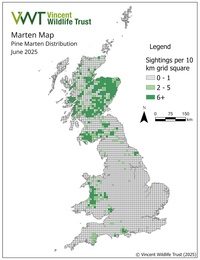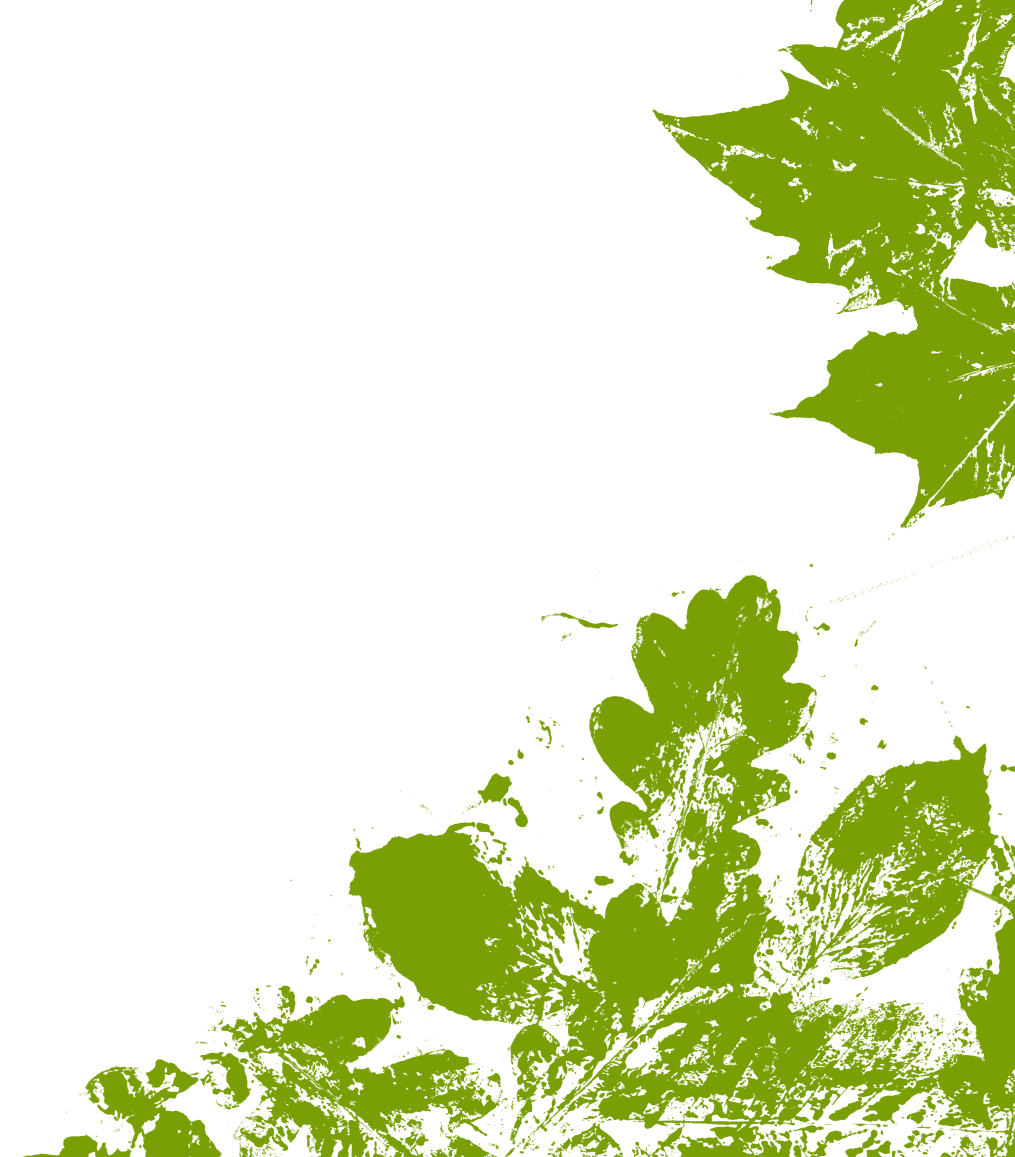Long-term strategic recovery plan for pine martens in Britain



Female |
Male |
|---|---|
| length 46-54cm | length 51-54cm |
| tail length 18-24cm | tail length 26-27cm |
| weight 1.5kg | weight 2kg |
| life span 7-10 years in the wild | life span 7-10 years in the wild |

The pine marten was thought once to be the second most common carnivore in Britain during the Mesolithic era. The clearance of woodlands, together with predator control, had a devastating effect on the pine marten population and by 1915 this species was confined to just a few of the more remote areas across Britain and Ireland and had become the second rarest carnivore. Small populations may have survivedsurvived in Wales and the Marches and in areas of northern England, with relatively strong populations still present in parts of the Scottish Highlands.
Today, populations are naturally expanding in number and range in Scotland and Ireland. In Wales, Vincent Wildlife Trust (VWT) carried out a pine marten population reinforcement between 2015 and 2017 by translocating pine martens to mid-Wales from Scotland, resulting in the re-establishment of a viable marten population. Although pine martens are spreading from southern Scotland and naturally re-colonising parts of Northumberland and Cumbria, they are still scarce in England with a restricted distribution. Between 2019 and 2021, VWT worked with Gloucestershire Wildlife Trust to reintroduce pine martens to the Forest of Dean; and with Devon Wildlife Trust and other regional partners (2024-2025) to reintroduce martens to Devon. Elsewhere in England, pine martens are present in Shropshire, Hampshire (the New Forest) and are occasionally recorded in other counties.

The pine marten was thought once to be the second most common carnivore across Britain and Ireland — but has now become the second rarest after the wildcat.
The pine marten received full legal protection in 1988 and today, populations are naturally expanding in number and range in Scotland and Ireland. Following VWT's translocations of pine martens from Scotland to mid-Wales, there is once again a viable population in Wales. Later translocation projects have led to small populations developing in Gloucestershire and in Devon.
The pine marten is classified as Critically Endangered in England and Wales by the Red List for Britain's mammals, but Least Concern in Scotland.

Pine martens usually have dark brown fur with a creamy-yellow throat patch known as a bib.
During the winter, the pine marten's fur is thick and fluffy for warmth and their summer fur is shorter and darker during the warmer months. Every pine marten's bib is unique — much like human fingerprints — and can help us to identify individual pine martens.
They have a long slim neck and body, which gives them great flexibility and a long, bushy tail that helps them to balance. They also have sharp, semi-retractable claws and ankles that rotate through 180o, which allows them to climb up and down the trees. Muscular legs and long feet help them leap from branch to branch.

Pine martens are arboreal, which means they are adapted to life in the trees where they are safer from predators such as foxes.
Since pine martens are generally solitary animals that live alone in territories, which can vary from around 1km2 to 30km2 in size and they need large mixed woodlands with a rich diversity of plants and animals to thrive. They also use a variety of habitats in addition to woodlands — such as scrub (habitat dominated by bushes and shrubs) and rough grassland for hunting food, but woodlands are where they typically rest and raise their young usually high in the trees.
Pine martens prefer to use tree cavities that are high enough to keep them safe from predators and big enough for a mum and kits. Many of the trees in Britain are not old enough to have such cavities large enough for pine martens to den in so VWT and other organisations, including community groups, are providing den boxes as safe spaces for pine martens.
Pine martens are a medium-sized mesocarnivore whose diet consists of 30-70% meat with the rest consisting of fruits, nuts, eggs, invertebrates and fungi.
Despite being classified as carnivores, pine martens are adaptable and opportunistic, which means that they change what they eat depending on the season and what is locally abundant. In the trees and bushes, they may eat squirrels, birds, insects, fruit and nuts. On the forest floors and in the scrub and grasslands they will eat small rodents, amphibians, reptiles, invertebrates, fungi and even carrion (dead animals). In Britain, voles are a particularly important prey item for martens. See FAQs for more information.
Because they have such a varied diet, pine martens play a vital role in helping to keep a natural and healthy balance of plants and animals in woodlands and forests.

Pine martens are considered slow breeders. They don’t start breeding until they are two or three years old, only breed once a year, and usually only have one to three kits (baby pine martens) in a litter.
Pine martens mate in mid-summer but give birth the following spring. Females have ‘delayed implantation', which means that any fertilised eggs are not implanted in the uterus for around 230 days. This strategy ensures that the kits are born during early spring when the weather is becoming warmer and food is more abundant.
When food has been particularly abundant, pine martens can have up to four or (rarely) five kits. When born, each kit weighs around 30g. Their eyes are closed and they have a fine covering of silver hair.
A safe den, which is elevated, warm and cosy, is crucial to the kits’ survival. They will stay in the den for about six or seven weeks and are totally dependent on the mother.

Once the kits are about seven weeks old and they start to explore the outside world, they will need to learn to climb very quickly since their dens are usually high up in a tree away from predators. Only a small number of juveniles will survive to become adults and breed. Pine martens can live up to twenty years in captivity but are only likely to make it to seven to ten years in the wild.
Following historical predator control and persecution, the main threats to pine martens today are predators such as foxes and occasionally larger birds of prey, along with habitat loss, roads and vehicle collisions.

The clearance of woodlands, together with predator control, had a devastating effect on the pine marten population and by 1915 this species was confined to just a few of the more remote areas across Britain and Ireland.
Pine martens are now legally protected under The Wildlife and Countryside Act (1981) and this, along with reintroductions to a few suitable locations, managed and carried out by VWT and other conservation organisations, is helping the species to slowly recover in parts of Britain.
Active
Programmes
VWT's Martens on the Move Project, funded by The National Lottery Heritage Fund, is a community action project to ensure that recovering pine marten populations continue to thrive across Britain.

Pine martens are now found in each of the three nations of Britain. Check out the Marten Map to see if they have been recorded near you.
Pine martens are related to badgers, otters and polecats, all of which are members of the weasel family or Family Mustelidae.
Mustelids are small to medium-sized carnivores, and most have long slender bodies, short limbs and long tails. The pine marten is a tree-dwelling mustelid, similar in size to a domestic cat, and has sharp, well-developed claws for climbing trees and a long tail to help it balance as it travels along branches.
Yes, because they have been present on the island of Britain for at least 6,000 years. They are believed to have been used as a source of fur by humans during the Neolithic period.
Pine martens and red squirrels have evolved together throughout their Eurasian range in a natural predator/prey relationship, though studies in Britain and Ireland show a low occurrence of red squirrel in the diet of pine martens.
Research in Ireland and Scotland has shown that where pine martens are naturally recovering their former range and have established good breeding populations, grey squirrel numbers are decreasing, allowing recolonisation of woodlands by red squirrels (see paper here and here). Scientists are not sure why or how this happens and further research is needed to fully understand the dynamics between the three species.
Although pine martens mainly predate on small mammals such as voles, birds form a part of their varied diet, and so wild birds and game birds (reared for shooting) may also be predated.
Before being hunted and trapped to near extinction, pine martens evolved and co-existed with all our native birds in the wild for thousands of years, and they play an important role in the food chain. Pine martens naturally occur in relatively low densities in the landscape and will take advantage of food sources that are locally abundant; they are therefore most likely to predate on bird species that are common and less likely to have an impact on rare birds. They are opportunistic and will predate on birds’ eggs if they come across a nest, something that many other native carnivores and bird species also do.
As pine martens eat what is most commonly and abundantly available, they are unlikely to significantly impact bats or hazel dormice. There is little evidence that pine martens regularly predate on bats, although there is a possibility that pine martens may use the same buildings to den in that bats also roost in.
As with pine martens, hazel dormice typically exist in low population densities in woodland. Hazel dormouse nest boxes have small entrance holes facing towards the tree trunk and lids are typically secured in place, to protect them from predators.
Pine martens are naturally curious animals and do visit gardens in search of an easy meal, such as food left out for family pets and wildlife, food stored in sheds or discarded in rubbish bins. They will, however, move away if no food is readily available.
To help make sure that any small pets (such as rabbits and guinea pigs) and hens are safe from pine martens, make sure that their housing is secure with no holes greater than 45mm that a marten may fit through. Pine-Marten-Leaflet.pdf (vwt.org.uk). If you have a pine marten visiting your garden, please let us know here.
If you see a pine marten in England, Wales or Scotland, please report your sighting here




[Archive Projects]
The People and Pine Martens in Wales (PPMW) project was a two year project, run during 2013 and 2014, which set out to address aspects of the national, stakeholder endorsed strategy for restoring the pine marten population in England and Wales.
